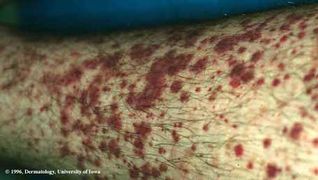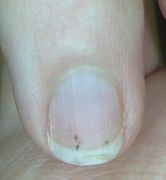We need you! Join our contributor community and become a WikEM editor through our open and transparent promotion process.
Purpura
From WikEM
(Redirected from Petechiae)
Contents
Background
- Palpable petechiae and purpura are a result of either perivascular inflammation (vasculitis) or infection.
- Non-palpable petechiae usually occur in low platelet states such as ITP and DIC
Rash Red Flags[1]
- Fever
- Toxic appearance
- Hypotension
- Mucosal lesions
- Severe pain
- Very old or young age
- Immunosuppressed
- New medication
Clinical Features
Both petechia and purpura do not blanch
- Purpura subdivided into:
- <2mm of hemorrhage: petechiae
- >2mm of hemorrhage: ecchymoses
Differential Diagnosis
Petechiae/Purpura (by cause)
- Abnormal platelet count and/or coagulation
- Septicemia
- Idiopathic thrombocytopenic purpura (ITP)
- Hemolytic uremic syndrome
- Leukemia
- Coagulopathies (e.g. hemophilia)
- Henoch-Schonlein Purpura (HSP)
- Acute hemorrhagic edema of infancy (AHEI)
- Hypersensitivity vasculitis
- Primary vasculitides
- Wegener's
- Microscopic polyangiitis
- Eosinophilic granulomatosis with polyangiitis (Churg-Strauss syndrome)
- Secondary vasculitides
- Connective tissue disorder
- Scurvy
- Infectious disease
- Hepatitis B
- Hepatitis C
- Trauma
Petechiae/Purpura (by findings)
- Febrile, toxic
- Palpable
- Meningococcemia
- Disseminated gonococcal infection
- Endocarditis
- Rocky mountain spotted fever
- HSP
- Non-palpable
- Palpable
- Afebrile, nontoxic
- Palpable
- Autoimmune vasculitis
- Non-palpable
- Palpable
Evaluation
Rash visual diagnosis
Splinter hemorrhage (endocarditis)
Management
- Management directed by underlying condition
Disposition
See Also
References
- ↑ Nguyen T and Freedman J. Dermatologic Emergencies: Diagnosing and Managing Life-Threatening Rashes. Emergency Medicine Practice. September 2002 volume 4 no 9.




